Telangana SCERT TS 8th Class Physics Study Material Pdf 7th Lesson Coal and Petroleum Textbook Questions and Answers.
TS 8th Class Physics 7th Lesson Questions and Answers – Coal and Petroleum Surfaces
Reflections on concepts
Question 1.
Explain why petroleum is also called as liquid gold?
Answer:
The substances which are obtained from petroleum are used in the manufacture of detergents, synthetic fibres etc., Due to its great commercial importance, petroleum is also called as ‘liquid gold”.
Question 2.
Name the petrochemical products which are used in agriculture industry.
Answer:
Plastic tubes, baskets, storing box, cultivation implement and fertilizers are the petrochemical products. which are used in agricultural industry.
Question 3.
Explain the process of formation of petroleum in Earth.
Answer:
- Petroleum was formed from organisms living in the sea. As these organisms died, their bodies settled at the bottom of the sea and got covered with layers of sand and clay.
- Over millions of years, absence of air, high temperature and high pressure transformed the dead organisms into petroleum.
Question 4.
Why should people look for alternative sources of fossil fuel?
Answer:
- Yes, alternative energy sources such as wind energy, solar energy can effectively replace fossil fuels.
- These are completely emission-free.
- This makes them extremely attractive from an environmental standpoint.
- Alternative sources of energy will provide a hedge against rising fuel prices.
![]()
Question 5.
Draw the diagram of uses of coal and its products.
Answer:
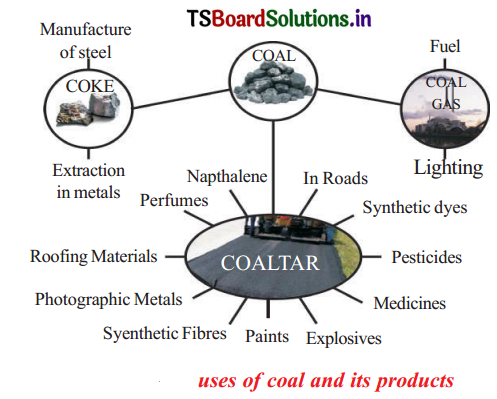
Application of concepts
Question 1.
Name the petroleum products used for surfacing of roads.
Answer:
1. Earlier coal-tar a black, thick liquid which is obtained from coal processing and is a mixture of about 200 substances was mainly used for metalling or surfacing of the roads.
2. Now – a – days ‘bitumen’ which is a petroleum product, is used in place of coal – tar for surfacing the roads.
Question 2.
What will happen if fossil fuels like coal and petroleum are completely exhausted?
Answer:
1. If fossil fuels like coal and petroleum are completely exhausted, then various industries like thermal power, steel, generators, petrochemical industries etc would be closed.
2. Transportation system which is completely based on motor fuels like diesel, petrol, CNG would be stopped.
3. Most of the rural and urban people use fuels like kerosene and LPG for cooking. This would be mostly effected on basic needs.
Question 3.
Assume that you are a driver, what measures do you take to save petrol and diesel?
Answer:
- I will check my vehicle tyres. Under inflation it can increase consumption of petrol or diesel.
- Keep constant and steady speed as far as possible.
- Switch off my vehicle engine in traffic jam.
- Turn off the air conditioner whenever possible.
- Plan my route mostly direct way.
- Never stay in low gear. Get into higher gear as possible as ¡ can.
- Maintain my vehicle engine regularly.
- I will never keep foot on clutch. It leads to more fuel consumption.
Question 4.
Suggest some alternative ways to save the fuel resources.
Answer:
- Use CNG as fuel for vehicles instead of petrol, diesel.
- Walk, and cycle for short distances.
- Use public transport instead of private vehicles.
- Turn off the ignition, when we were in waiting at the signal for more than one minute.
- Drive at speeds that optimize fuel consumption.
Question 5.
How do you appreciate the efforts of human beings to discover alternate energy sources to Coal and Petroleum for their daily use?
Answer:
- Each person uses a good deal of energy in the form of fossil fuels like coal and petroleum.
- Every day we bath, cook, clean, do laundry, drive and use products created from these fossil fuels.
- Coal is an ancient gift serving modern society.
- Due to the great commercial importance of petroleum, it is also called “black gold”.
![]()
Question 6.
Collect information about places where we get coal, petroleum and natural gas in India and mark the places on outline map of India.
Answer:
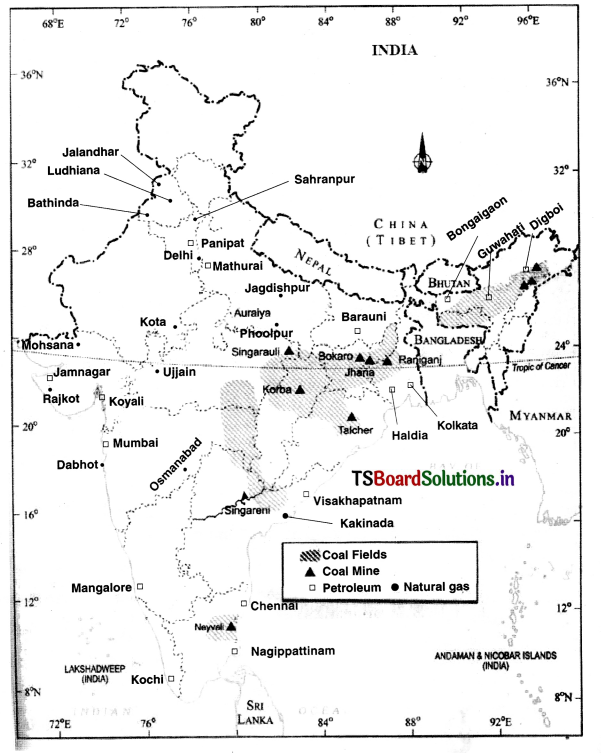
Higher Order Thinking Questions
Question 1.
How is biodiversity effected by the excessive use of fossil fuels?
Answer:
- Burning fuels releases carbon dioxide a greenhouse gas: which causes climate changes and leads to global warming.
- Coal-fired plants (industries) emits mercury, selenium, arsenic, lead in addition to greenhouse gases which are harmful to human health and environment.
- Many points from petroleum and heavy metals release toxic products into air. These toxic products cause various health problems including heart, lungs damage, nausea and dizziness.
- Because these toxic materials the survival of aquatic life, wildlife and birds life becomes more difficult which effects the biodiversity.
Question 2.
“Crude oil and refined fuel when spills into the sea from tanker of ships by accident”. Discuss the consequences of this on environment.
Answer:
- Oil spills often result in both immediate and long-term environmental damage to natural ecosystem.
- They damage beaches, mangrove forests and marine ecosystems.
- They kill sea birds, marine mammals and shellfish.
- It will also destroy wildlife habitats and breeding grounds.
Multiple Choice Questions
Question 1.
Which one of the following is less polluting fuel [ ]
a) Natural gas
b) coal gas
c) Kerosene
d) Petrol
Answer:
a) Natural gas
Question 2.
The main constituent of coal is [ ]
a) Carbon
b) Oxygen
c) Air
d) Water
Answer:
a) Carbon
Question 3.
Which one of the following materials is used for making shoe polish [ ]
a) Paraffin wax
b) Petrol
c) Diesel
d) Lubricating oil
Answer:
a) Paraffin wax
![]()
Question 4.
Which of the following is not a fossil fuel [ ]
a) Coal
b) Petroleum
c) Charcoal
d) Natural gas
Answer:
d) Natural gas
Question 5.
Which of the following is known as liquid gold [ ]
a) Kerosene
b) Diesel
c) Petroleum
d) Paraffin wax
Answer:
c) Petroleum
Suggested Experiments
Question 1.
Conduct an experiment to show that when we heat high-quality coal,a gas evolves which can burn.
Answer:
Aim: To show that when we heat high quality coal (carbon content is more) a gas evolves which can burn.
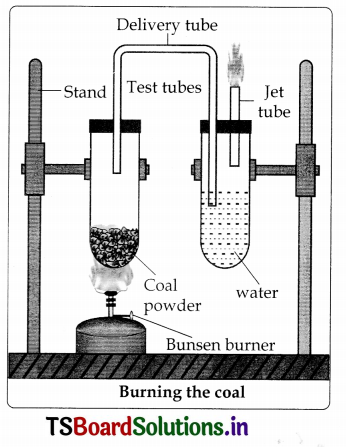
Material required: Two boiling test tubes, rubber cork, iron stands, delivery tube, jet tube, bunsen burner.
Procedure: Take a spoon of powdered coal and place it in a hard glass test tube and fix it to a stand as shown in the figure.
Close the open end of the test tube with a rubber cork and connect it to another test tube which is partially filled with water and has fixed to other stands, with the help of ‘U’ shaped delivery tube as shown in the figure. Heat the test tube strongly with the help of bunsen burner.
Test the gas evolved by the second test tube through the jet tube fixed to it, by bringing a lighted match stick near to its nozzle. You may notice that the brownish-black vapours evolve.
Suggested Projects
Question 1.
Burning fuels releases carbon dioxide, a greenhouse gas, which causes climate changes and leads to global warming. Collect information about this through newspapers, magazines etc. and prepare report.
Answer:
i. Most of the harmful effects ¿ire due to our carelessness. For example, crude oil and refined fuel spills from tanker ship accidents have damaged natural ecosystem. This can kill sea birds, mammals, shellfish and other organisms.
ii. Burning fuels release carbon dioxide, a greenhouse gas, which causes climate changes and leads to global warming.
iii. Coal-fired power plants emits mercury, selenium and arsenic which are harmful to human health and environment.
iv. Products from the coal and petrol can also harmful.
v. Many paints are petroleum based with some toxic substances added. Long after we finish painting, they release toxic products in air. This can cause a variety of health problems including heart and lung damage nausea and dizziness.
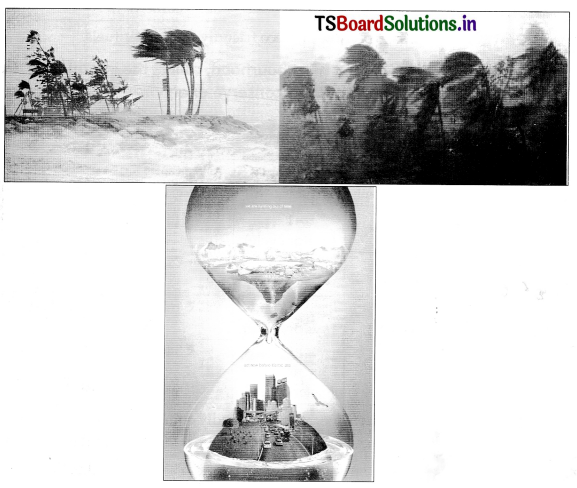
Report: Overuse of C.F.Cs causes global warming.
![]()
Question 2.
Compare a CNG-run vehicle with that of a diesel-run vehicle. What difference do you notice in both cases with respect to pollutants released, level of pollution and cost of fuel.
| Name of the fuel | Cost of the fuel as on today | Pollutants liberated |
| Diesel/ Petrol | ||
| CNG |
Answer:
| Name of the fuel | Cost of the fuel as on today | Pollutants liberated |
| Diesel/Petrol | Diesel: ₹ 51.35 / Ltr Petrol: ₹ 73.73/Ltr |
Carbon dioxide, carbon monoxide, nitrogen dioxide, hydrocarbons, particulate matter and lead. |
| CNG | CNG: ₹ 40/ Kg | Negligible sulphur dioxide content does not contain lead, low nitrogen dioxide and particulate content, and low carbon monoxide content. |
Report: C.N.G is less expensive and eco-friendly than other fuels.
Question 3.
Choose five families of your neighbourhood, collect the information about the measures that they adopt to conserve energy resources in transport and cooking.
Make a report on your observation
| Name of the Head of the family | Number of members in family | No of vehicles using | Amount spent for Fuel in one month | Amount spent for the Cooking purpose |
Answer:
| Name of the family | Number of members in family | No of vehicles using | Amount spent for fuel in one month | Amount spent for cooking purpose |
| 1. Prasad | 4 | 1 (motorcycle) |
₹ 850 | ₹ 380 |
| 2. Shyam | 3 | 1 (motorcycle) |
₹ 0 | ₹ 240 |
| 3. Sivaji | 8 | 2 (motor cycle) |
₹ 1675 | ₹ 550 |
| 4. Paul | 7 | 1 (car-1) (motorcycle) |
₹ 3400 | ₹ 500 |
Report: Cycle is less expensive, and eco-friendly compared to other vehicles.
TS 8th Class Physics 7th Lesson Coal and Petroleum Activities
Activity – 1:
IdentifvinE articles and materials used for various purposes (Text. P.No. 94)
Question 1.
Make a table as Column (A) gives the names of some activities’ arid items. Ask your grandparents or other older people and write down the names of the materials then used against the item given, in column B. In column C, write the names of materials being used at present. And also answer the following questions. (Information skills).
Answer:
Table
| Articles/Activities (A) | Article/ Materials used 30-40 years ago (B) | Articles/ Materials used Today (C) |
| Containers for storing pickle | clay jars,………….. | plastic |
| Packing food for a journey | clothes, leaves | plastic tiffin |
| Water pipes in the house | metal pipes | PVC |
| Hair combs | wooden | plastic |
| Vessels for cooking food | copper vessels | steel utensils,…………. |
| Fuels used to cook food | wood, coal | kerosene, LPG |
| Fuel used in a train engine | coal | diesel, … |
| Luggage for carrying clothes | metal trunks, … | plastic suitcase |
| Water buckets, pails | metal buckets | plastic buckets |
| Water storages in houses | metal containers (brass) | plastic buckets,… |
| Construction material | clay, limestone | cement, steel |
| Jewellery | metals like gold, silver, diamonds | gold, silver, platinum, diamonds |
| Furniture (chairs, beds) | wood | plastic |
Questions based on the above Activity – 1
Now think and write the answers: (Text. P. No. 94 & 95) (Information skills)
a. How many of these materials were available 10 years ago?
Answer:
Plastic, polythene, PVC pipes, LPG
b. How many of these materials were available 50 years ago? (Information skills)
Answer:
Steel utensils, petroleum products like kerosene and diesel etc.
c. How many of these materials were available 100 years ago? (Information skills)
Answer:
Clay jars, metals like iron, silver, gold, coal, wood, glass.
Activity- 2 :
List out the natural resources which are limited and which are abundant (Text. P. No.96)
Question 2.
Table (Concepl understanding/Project Work)
| Resources Abundant | |
| Resources Limited |
Answer:
Resources Abundant air solar energy
Resources Limited coal petroleum minerals
Questions based on the above Activity- 2
a. What will happen if fossil fuels like coal and petroleum are completely exhausted? (Text. P. No. 97) (‘Making hypothesis/Conceptual understanding)
Answer:
- If fossil fuels like coal and petroleum are completely exhausted, then various industries like thermal power, steel, generators, petrochemical industries etc would be closed.
- Transportation system which is completely based on motor fuels like diesel, petrol, CNG would be stopped.
- Most of the Rural and Urban people use fuels like kerosene and LPC for cooking. This would be mostly effected on basic needs.
b. What would be our future energy resources? (Text. P.No. 97) (Aesthetic sense/Bio – diversity /Conceptual understanding)
Answer:
- Our country has enormous unconventional gas resources like coal bed methane, underground coal gas and gas hydrates. In the future, producing these unconventional gases. we would meet the energy demands.
- Renewable energy sources Like solar energy, wind energy, biogas, biomass, hydrogen, ocean thermal energy would be our future energy sources.
c. Are the fossil fuel resources available plenty to meet the future energy needs? (Text. P.No. 97 (Conceptual understanding)
Answer:
- No, the fossil fuels resources available to u are not sufficient to meet our future energy needs.
- Due to supply is limited and increase of demand these fossil fuels would be more expensive in future.
d. What actions required to meet the future energy needs? (Text. P.No. 97) (Information skill! Conceptual understanding)
Answer:
- First, we should conserve the fossil fuel resources as much as possible by reducing misuse.
- To encourage and educate the people for usage of renewable energy sources like solar energy, wind power etc.
![]()
Activity – 3:
Identlfvhw various uses petroleum (Text. P. No. 100)
Question 3.
What are various uses of by-products of petrol?
Answer:
Uses of by-products of petroleum:
- Pehol is used as motor fuel, aviation fuel and solvent for dry cleaning.
- Kerosene is used as fuel for stoves, lamps and et aircrafts.
- Diesel is used as fuel for heavy motor vehicles, electric generators etc.
- Paraffin wax is used as ointment, candles and vaseline.
Activity -4:
Identifying uses of coal products (Text. P. No. 101)
Question 4.
Draw a flow chart showing varic.us uses of coal products. (Drawing)
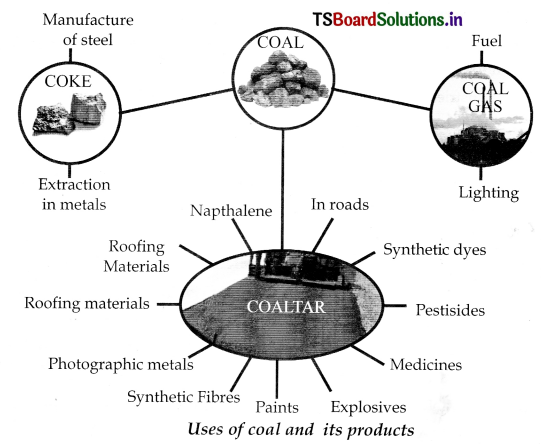
a. What are the uses of coal products?
Answer:
The coal products are:
| Coke | Coal Tar | Coal Gas |
| Manufacture of steel Extraction of metals Manufacture of water gas and producer gas | In roads, synthetic dyes, pesticides, medicines explosives, paints, synthetic fibres, photographic metals, roofing materials, naphtalene, plastic, perfumes, insecticides |
Fuel
Lighting |
Activity 5:
Group discussion on misuse of fuel resources and its consequences (Text. P. No. 104)
Question 5.
Discuss in small groups how fuel resources are being misused in our daily life while doing various activities like… (information skills)
a) transport
b) cooking
c) use of electric appliance
Answer:
a) Transport:
- Most of the people do not ensure correct vehicle tyre pressure.
- Do not maintain engines regularly.
- Lack of proper knowledge about fuel economy.
b) Cooking:
- By using old conventional cooking vessels, not using pressure cookers.
- Open vessel cooking.
- Using so much of water while cooking.
- Not proper regular checking regulator, pipes, burner for leaks.
c) Use of electrical appliances :
- Using incandescent lamps instead of CFL
- Using lights in day time, proper ventilation would be the solution.
- Leaving electrical appliances on, when they were not in use,
- Using conventional regulators.
- Wet cloth ironing.
- Use of drier in washing machine.
Questions based on the above Activity – 5
a. What are the consequences of misuse of fuels? Prepare a report. (Text. Pg. No. 104) (Applications to daily life)
Answer:
- Misuse of fossil fuels releases a lot of pollutants into the atmosphere, which have various environmental effects.
- Burning of so much Fuel also causes ozone depletion. This may result hazards like global warming.
- A direct consequence is rising fuel costs. With rising demand and a limited supply, this is simply a matter of economics.
b. What methods could you suggest to prevent the misuse of fuels? (Text. P.No. 104)
Answer:
Suggestions to prevent the misuse of fuels:
- More efficient engines and combustion systems.
- Less intensive processing.
- Heat and energy recovery and reuse.
- Alternate delivery systems (mass transit rather than private vehicles.)
- Improved energy conservation (insulation)
Lab Activity
Question 1.
Show that when high-quality coal is heated, a gas evolved which can burn. (Experimentation )(Text. Pg. No. 101)
Answer:
Aim: To show that when we heat high-quality coal (carbon content is more) a gas evolves which can burn.
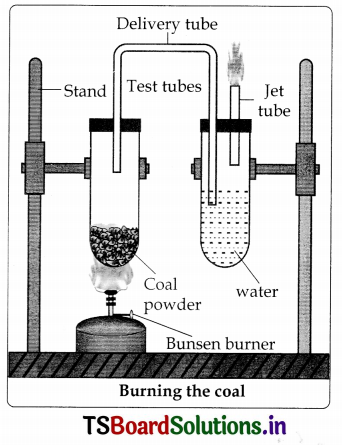
Material required: Two boiling test tubes, rubber cork, iron stands, delivery tube, jet tube, bunsen burner.
Procedure: Take a spoon of powdered coal and place it in a hard glass test tube and fix it to a stand as shown in the figure.
Close the open end of the test tube with a rubber cork and connect it to another test
tube which is partially filled with water and has fixed to other stands, with the help of ‘U’ shaped delivery tube as shown in the figure. Heat the test tube strongly with the help of bunsen burner.
Test the gas evolved by the second test tube through the jet tube fixed to it, by bringing a lighted match stick near to its nozzle. You may notice that the brownish-black vapours evolve.
The above vapours passed through water contained in a test tube. Colourless gas bubbles come from the water. 1f you burn the gas that is evolving through the jet tube. You can witness a bright flame at the nozzle. From this we conclude that when we heat high-quality coal, a gas evolves which can burn.
a. Repeat the above experiment if we replace lime water, soapy water instead of water used in second boiling. What do you observe? Give reasons for the changes you observed in two experiments. (Experimentation & F.I.) (Text. Pg. No. 102)
Answer:
- By replacing lime water instead of water used in the second test tube, after heating the first test tube carbon dioxide gas is evolved and it turns lime water into milky.
- By replacing soap water instead of water used in the second test tube, after heating the first test tube carbon dioxide gas is evolved and it forms a precipitate.
- This is because of carbon dioxide gas is acidic in nature.
b. What inference can you draw from these experiments? (Text. P.No. 102) (Experimentation & F.I.)
Answer:
Inference: When coal is heated in the first test tube since the coal mainly contains carbon. It emits carbon dioxide gas. Due to acidic nature of carbon dioxide gas, it turns lime water into milky and forms precipitate with soap water.